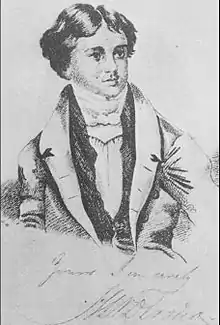Sib Chandra Deb
Sib Chandra Deb (Bengali: শিবচন্দ্র দেব Shib Chôndro Deb) (also spelt Shib Chandra Deb, Shibchandra Deb, Shib Chander Deb) (20 July 1811 – 12 November 1890) was one of the leading Derozians, virtually the first generation of English-knowing Indians. He had joined Hindu College in 1825 and was subsequently drawn towards Derozio. Sivanath Sastri recalls that even in his old age he fondly recalled in detail what Derozio used to say. A brilliant student he won a scholarship while studying at Hindu College. As a student, he occasionally attended the meetings of the Brahmo Sabha established by Raja Rammohun Roy. Initially, he joined the survey department as he had acquired proficiency in higher mathematics but changed over to general administration to become a deputy collector in 1838. The English allowed Indians to be promoted/ posted as deputy collectors in 1833. He was one of the early English-knowing Indian officials in government service.
Sib Chandra Deb শিবচন্দ্র দেব | |
|---|---|
 | |
| Born | 20 July 1811 |
| Died | 12 November 1890 (aged 79) |
| Nationality | Indian |
| Occupation | Deputy Collector |
Brahmo Samaj
He joined the Brahmo Samaj in 1843, around the same time as Debendranath Tagore, and rose to be one of its prominent leaders by the 1850s. He established the Medinipur Brahmo Samaj in 1846 and the Konnagar Brahmo Samaj in 1863. At the time of founding of the Brahmo Samaj of India, he was with the progressives and assisted the movement in many ways. At the time of establishment of the Sadharan Brahmo Samaj, his sympathies were with the protesting party. He was one of the leaders of the Sadharan Brahmo Samaj, along with Sivanath Sastri, Ananda Mohan Bose, Umesh Chandra Dutta and Durga Mohan Das, when it was established in 1878 and was its first president and subsequently for many years.
After the second break-up of the Brahmo movement, his house at Konnagar became a place of pilgrimage to the members of the new samaj. They would often flock there so that his example of earnest piety, inborn humility, wide range of knowledge, methodical performance of the smallest duties of life, moderation in speech and conduct and constant attention to the good of others could inspire them. Indeed, he was the living embodiment of an ideal Brahmo life.
He was one of strongest proponents of women's education because he was convinced that society could not progress unless women were educated. He admitted his daughters into Bethune School. In 1860, he opened a girls' school in his own house. It later shifted to a building of its own. He wrote a book Sishupalan (child care) for use by women.
Posted for sometime in 24 Parganas, he participated actively in the social life of Kolkata during the period. He contributed considerably to the development of Konnagar, including the inauguration of Konnagar railway station in 1856 and a post office in 1858. He was commissioner of Serampore municipality from 1865 to 1878. His father Braja Kishore Deb was in government service and was considered to be a moneyed man.
Brahmo marriage consternation
Satyapriya Deb, son of Sib Chandra Deb, was married, in 1876, to Saratkumari, daughter of Kalinath Bose, a close friend and devotee of Keshub Chunder Sen. Trouble started with a notice in the Indian Mirror about performance of the marriage as per the reformed ceremonies of the Brahmo Samaj. It was to be organised without the presence of Brahmin priests and without any salagram shila (family stone deity) or the traditional hom or fire witnessing (agni sakshi). Many considered it a challenge to traditional Hindu society and systems. There was considerable public consternation about the marriage and the possibility of large-scale demonstrations against the proposed marriage rites loomed large over the occasion. The danger of people coming and physically disrupting the marriage ceremony was a distinct possibility.
Kalinath Bose rushed to Keshub Chunder Sen. He took personal interest to find a suitable alternative place of wedding on Circular Road. Almost everything had to be organised afresh. The groom's party came by boat under police guard. There was a distinct fear that somebody could attack the groom en route. The marriage took place under extremely difficult circumstances. Many of those who came to attend the wedding were jeered.
Sivanath Sastri mentions this marriage as one of the notable social incidents of that period in his book Ramtanu Lahiri O Tatkalin Banga Samaj. Saratkumari Deb has given vivid details of the wedding ceremony in her book Amar Sansar.
References
- Shastri, Shibnath, Ramtanu Lahiri O Tatkalin Banga Samaj, 1904, p 134, S.K.Lahiri & Co.
- Lethbridge, Roper, Sir, Ramtanu Lahiri-Brahman and Reformer, published 1907, p. 189, Swan Sonnenschein & Co. Limited, London
- Ramtanu Lahiri O Tatkalin Banga Samaj in Bengali by Sivanath Sastri
- Sansad Bangali Charitabhidhan (Biographical dictionary) in Bengali edited by Subodh Chandra Sengupta and Anjali Bose
